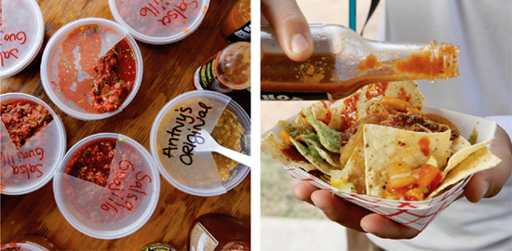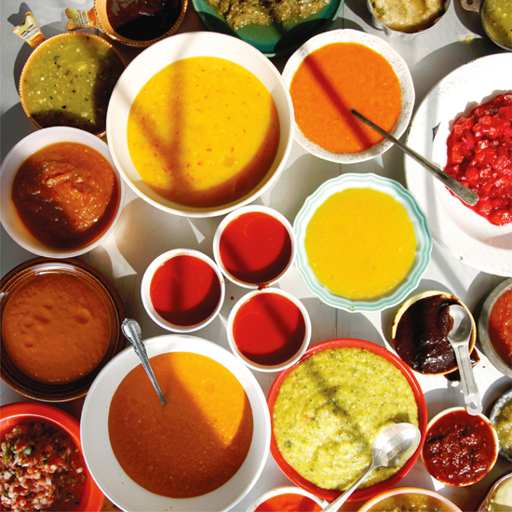The Hot Sauce Cookbook
Read The Hot Sauce Cookbook Online
Authors: Robb Walsh


Copyright © 2013 by Robb Walsh
Photographs copyright © 2013 by Todd Coleman
All rights reserved.
Published in the United States by Ten Speed Press, an imprint of the Crown Publishing Group, a division of Random House, Inc., New York.
www.crownpublishing.com
www.tenspeed.com
Ten Speed Press and the Ten Speed Press colophon are registered trademarks of Random House, Inc.
Grateful acknowledgment is made to the following for permission to reprint previously published material:
Clarkson Potter/Publishers and David Chang: The recipe “
Red-eye Mayonnaise
” from
Momofuku
by David Chang and Peter Meehan, copyright © 2009 by David Chang and Peter Meehan. Adapted by permission of Clarkson Potter/Publishers, an imprint of the Crown Publishing Group, a division of Random House, Inc., and David Chang.
Zak Pelaccio: The recipe “
Malaysian Chicken Wings
” by Zak Pelaccio (
Food and Wine
magazine, January 2006). Adapted by permission of Zak Pelaccio.
Ten Speed Press and Randy Clemens: The recipe “Sriracha-Sesame Fruit Salad” from
The Sriracha Cookbook
by Randy Clemens, copyright © 2011 by Randy Clemens.
Adapted by permission of Ten Speed Press and the author.
Library of Congress Cataloging-in-Publication Data is on file with the publisher.
eBook ISBN: 9781607744276
Hardcover ISBN: 9781607744269
v3.1
CONTENTS
Fried Chiles (
Chiles Toreados
)
CHAPTER 2
MESOAMERICAN CHILMOLES
“Son of Suchilquitongo” Salsa Verde
David Garrido’s Ancho-Tomatillo Sauce
Homemade Buffalo Chicken Wings
CHAPTER 5
INTERNATIONAL PEPPER SAUCES
Nuoc Mam Cham (Vietnamese Dipping Sauce)
Goi Cuon (Vietnamese Summer Rolls)
CHAPTER 6
CHILEHEAD CHEFS’ HOT SAUCES
Raj Dixit’s Tomato-Coriander Berbere
Raj Dixit’s Green Curry Chow-Chow
Zak Pelaccio’s Malaysian Chicken Wings
Bryan Caswell’s Sriracha Citrus Remoulade
Bryan Caswell’s Shrimp with Sriracha Citrus Remoulade
Randy Clemens’s Sriracha-Sesame Fruit Salad
Chris Shepherd’s Nuoc Cham Chicken Salad
Stephan Pyles’s Shrimp Ceviche
Stephan Pyles’s Habanero Cranberry Sauce
INTRODUCTION
Chile peppers are totemic in many cultures—that now includes our own. In 1992, when sales of salsa surpassed ketchup, newspaper columnists, sociologists, and grocery industry gurus marked it as a major milestone, an indicator of irreversible changes in the ethnic makeup of our society. By 2002, the space allotted to hot sauces and salsas in the average supermarket went from a few feet of shelf space to close to an entire aisle. At the fast-food counter and the condiment station of the ballpark, hot sauce has joined ketchup and mustard in the plastic-squeeze-packet pantheon.
Business Week
’s list of the twenty-five top-selling condiments in America includes six salsas and four pepper sauces. The hot parade shows no sign of letting up. The 2012 Culinary Trend Mapping Report by food-industry think tank Packaged Facts declared that hot and spicy foods were still one of the fastest growing segments of the grocery business. The researchers reported that multicultural Generation Y and the growing Asian demographic were “eager to try bigger, bolder, hot and spicy flavors in nearly every daypart, food and beverage category, and season.”
From the mainstream American point of view, hot and spicy food seems like something that’s arrived on the culinary scene in the last twenty years. But while some of the brand names might be new, the recipes for the hot sauces contained inside the bottles go back hundreds and, sometimes even thousands, of years.
This book is a casual tour of hot-sauce history, a practical guide for making it at home, and an exploration of the strange relationship between humankind and hot and spicy food.
In six chapters, we consider where hot sauce came from and where it’s going.
Chapter 1
introduces some key hot sauce terminology and also describes the various peppers that are used in recipes throughout this book. In
chapter 2
, you’ll see how your favorite Mexican salsa recipes evolved from centuries-old Mesoamerican “chilmoles.”
Chapter 3
will give you some new ideas
about how to use the habanero-type chiles of the Caribbean islands, and recounts the story of the pepper sauces that made those intensely hot chiles famous.
Chapter 4
follows the fortunes of the Louisiana pepper sauce moguls, and offers recipes for making your own fermented pepper sauces at home.
Chapter 5
is a world tour of international hot sauces, including do-it-yourself recipes for Thai Sriracha, Ethiopian berbere, and Indonesian sambal oelek. Finally, in
chapter 6
we’ll see how some of America’s top chefs are using hot sauces to raise the profile of fiery food in contemporary American cuisine.


———CHAPTER 1———
HURTS SO GOOD
Like coffee, tea, and marijuana,
chile peppers are considered to be psychotropics. When you bite into a chile pepper, or eat a little hot sauce, the chemical
capsaicin stimulates the salivary glands and the sweat glands and causes the brain to release endorphins, the natural painkillers that are stronger than morphine. Was it the mind-altering qualities of chile peppers that made them attractive to our cave-dwelling ancestors, or was it the zip they added to a boring diet? Or was it a little of both?
Whatever caused early man to love them, the chile pepper acquired mystical significance. The pods were used as currency in ancient Peru and appear in Incan stone carvings. In pre-Colombian Mesoamerica, peppers were prescribed for coughs, sore throats, and infections. The Spanish missionaries tried to ban them because they thought that chile peppers induced lust.
While English sailors were called “limeys” because they took citrus fruit juice to prevent scurvy, their counterparts on Spanish ships ate chile peppers for the same reason. Ounce for ounce, green chiles have twice as much vitamin C as oranges. They are also rich in vitamins A, C, and E, and packed with iron, magnesium, niacin, riboflavin, thiamin, and potassium. Capsaicin, which can be extracted from chiles, is also used to treat chronic pain.